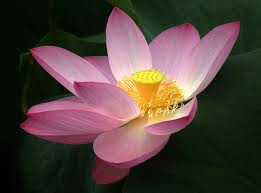





If there is sufficient light and warmth, a wide range of beautiful and exotic aquatic plants can be grown in an indoor pool, turning it into a tropical extravaganza. In a heated conservatory, the pool can provide an almost year-round cavalcade of colour, although with dull winter skies and shorter days, some of the most spectacular aquatic plants may sulk.
Of all tropical aquatic plants, one of the best known and easiest grown is the Egyptian papyrus (Cyperus papyrus). This is a towering plant of somewhat spidery palm-like appearance, which retains its character throughout the year if the correct temperature is maintained. It would be too tall for a small pool, but the shorter growing garden variety, ‘Haspan’, can be used to almost equal effect and may even he grown in an indoor tub or aquatic planter.
The banana-plant-like thalias offer similar benefits and, while looking regal and tropical, are really quite tough. Grow these alongside the papyrus for a truly exotic tropical effect, disguising their containers by planting around them with parrot’s feather (Myriophyllum proserpinacoides), a hardy scrambling plant that responds well to warm conditions.
As with an outdoor pool, waterlilies will be the centrepiece of an indoor water feature. The tropical forms will only grow well in still water, so a fountain or cascade cannot be allowed. However, the great beauty of these plants will compensate for the lack of moving water, especially when it is realised that their glory can be enjoyed day and night.
Tropical waterlilies are divided into two main groups: the day flowering and the nocturnal. Of all aquatic plants, the night blooming waterlilies are the most spectacular. Imagine sitting beside a pool in the evening, with exotic blossoms up to 30cm (12in) across unfurling as the sun sets. These big velvety blooms can also be picked and used as indoor table decorations for a special dinner party. Although of exotic appearance, if kept consistently warm, tropical waterlilies are not difficult to cultivate, but they are rarely a year-round proposition, benefiting from a dormant period when they should be lifted and stored in cool frost-free conditions. For the best results, they should be treated rather like tuberous begonias, being started into growth afresh each spring.
Lotus, or nelumbos, should be treated in a similar manner when grown in the confines of an indoor pool. Although they do not have to be lifted each autumn, doing so will provide the opportunity of replacing the compost each spring when replanting takes place. This is sensible, for the lotus is a gross feeder, but it is also a rapid grower.
Lotus are legendary plants of tropical water gardens, being known to gardeners and non-gardeners alike. In some parts of the world, they have religious significance, and they also play an important part as a food source. In the main, however, they are prized for their decorative value.
 The common sacred lotus (Nelumbo nucifera), which is the parent of most modern hybrids, is a large plant that rarely can be accommodated in a modern conservatory pool.
The common sacred lotus (Nelumbo nucifera), which is the parent of most modern hybrids, is a large plant that rarely can be accommodated in a modern conservatory pool.
Where there is sufficient space, it makes a spectacular sight, with its huge plate-like leaves and deep rose or pink blossoms. It is best replaced by one of the shorter growing types, such as the double-carmine-flowered ‘Momo Botan’, which rarely exceeds 45cm (18in). and will even produce beautiful flowers in a tub kept in a conservatory.
Consider the tub and similar containers as viable options for indoor aquatic cultivation. Many of the popular varieties can be grown successfully as solitary specimens in tubs of water with soil or aquatic compost on the floor. Do not try to create a balanced aquatic environment by mixed planting: enjoy the individual plants for their own sake.
If there is room for several containers, they can be assembled as a water feature. Group them together and, provided that they are of similar height, surround them with a length of log roll. This is sold in garden centres for edging paths and beds. It comprises short logs, of uniform length and diameter, held together with strong wires. The log roll will provide a neat edge to the feature. Being flexible, it can be adjusted as necessary to allow the removal of any tub that has finished flowering and looks untidy.
Of course, even smaller features can be planted to good effect, being placed in the conservatory or living room. Large terracotta or earthenware vases and bowls, intended for outdoor planting, can be used for growing individual plants. Often, they are decorated with oriental designs, which can be tastefully matched with appropriate looking plants to produce a special effect. Tropical aquatic plants need not be solely the prerogative of the indoor pool owner; they are sufficiently versatile to be enjoyed by anyone, irrespective of circumstances.
Copyright © www.100flowers.win Botanic Garden All Rights Reserved